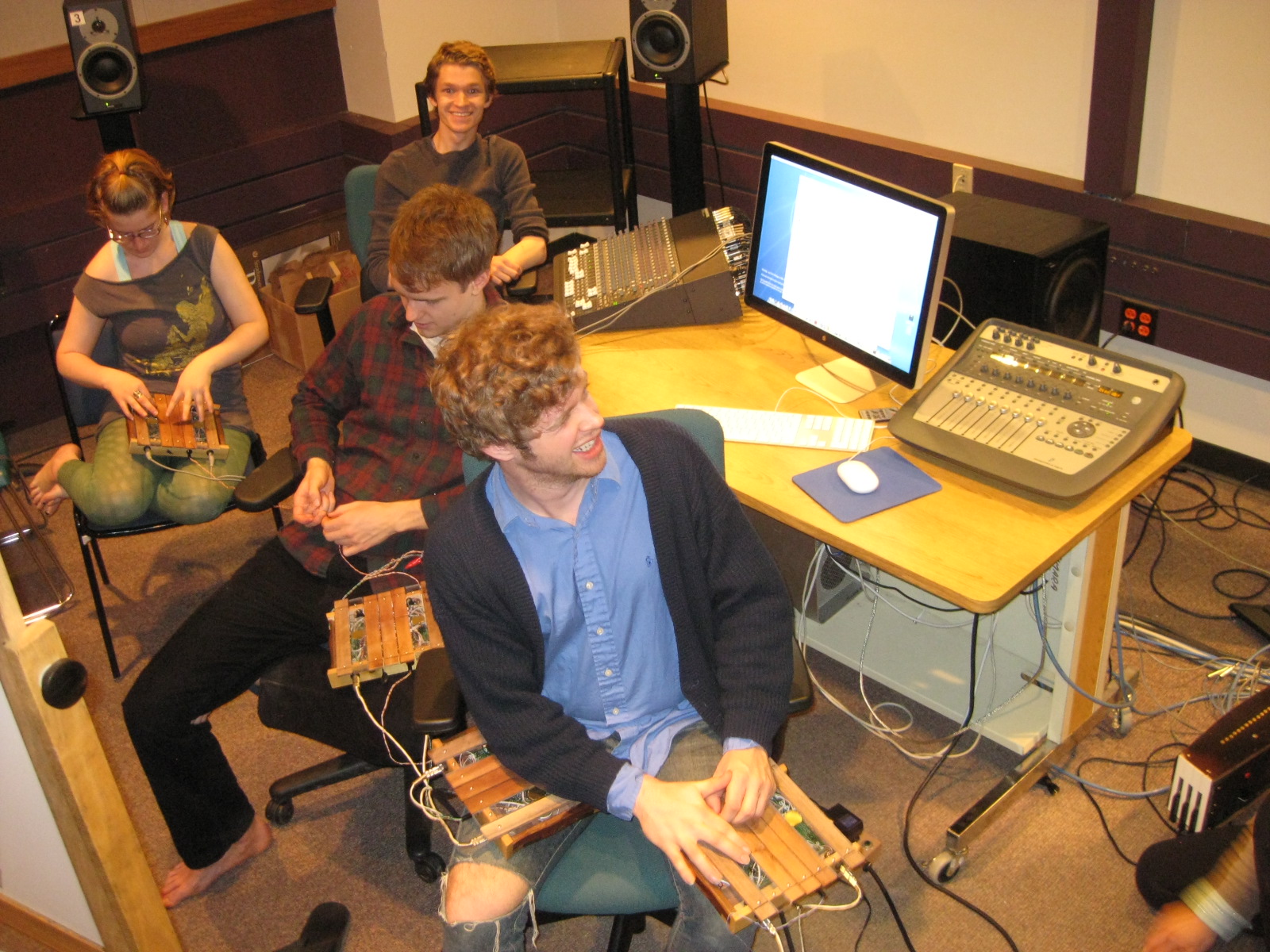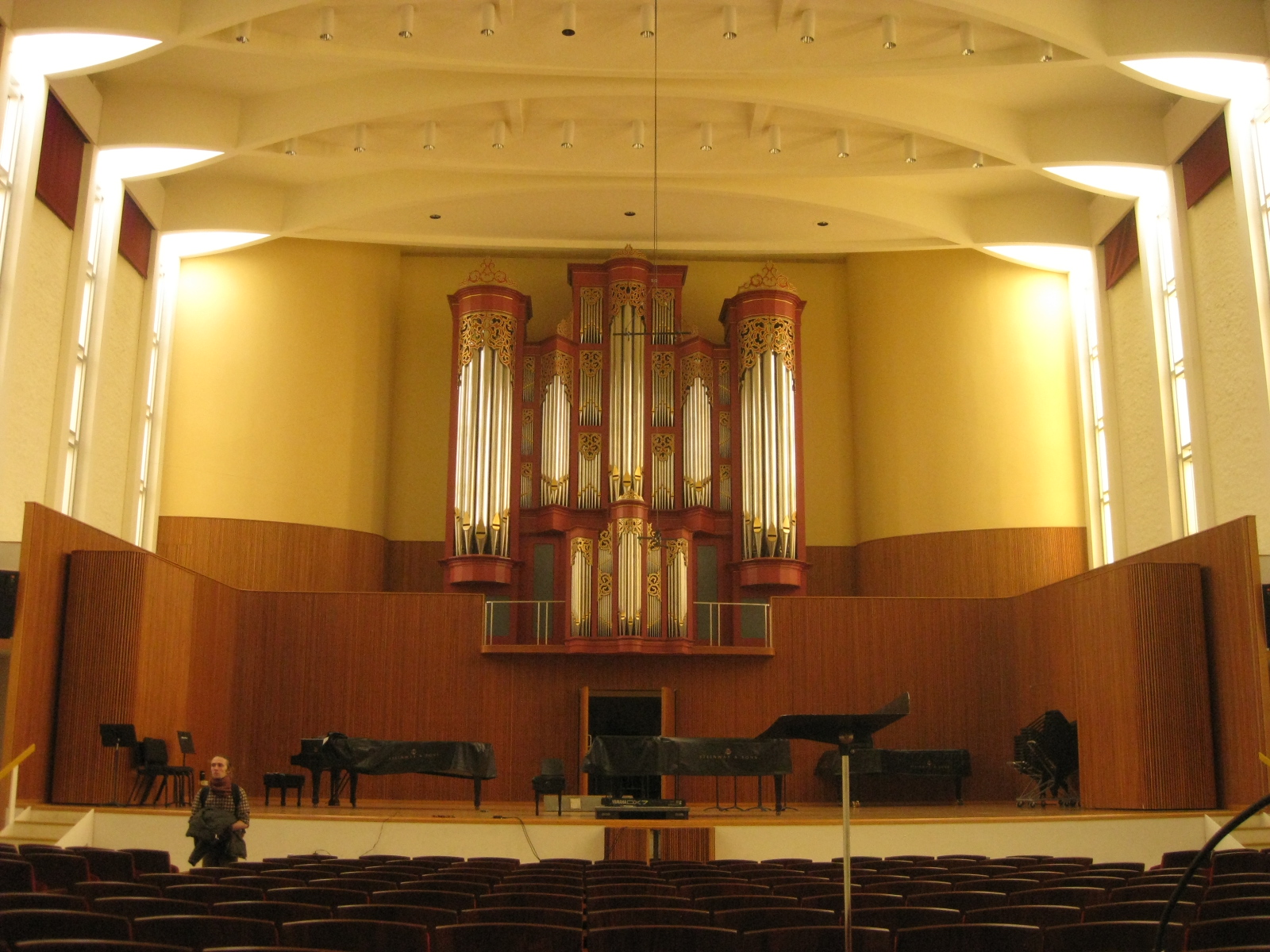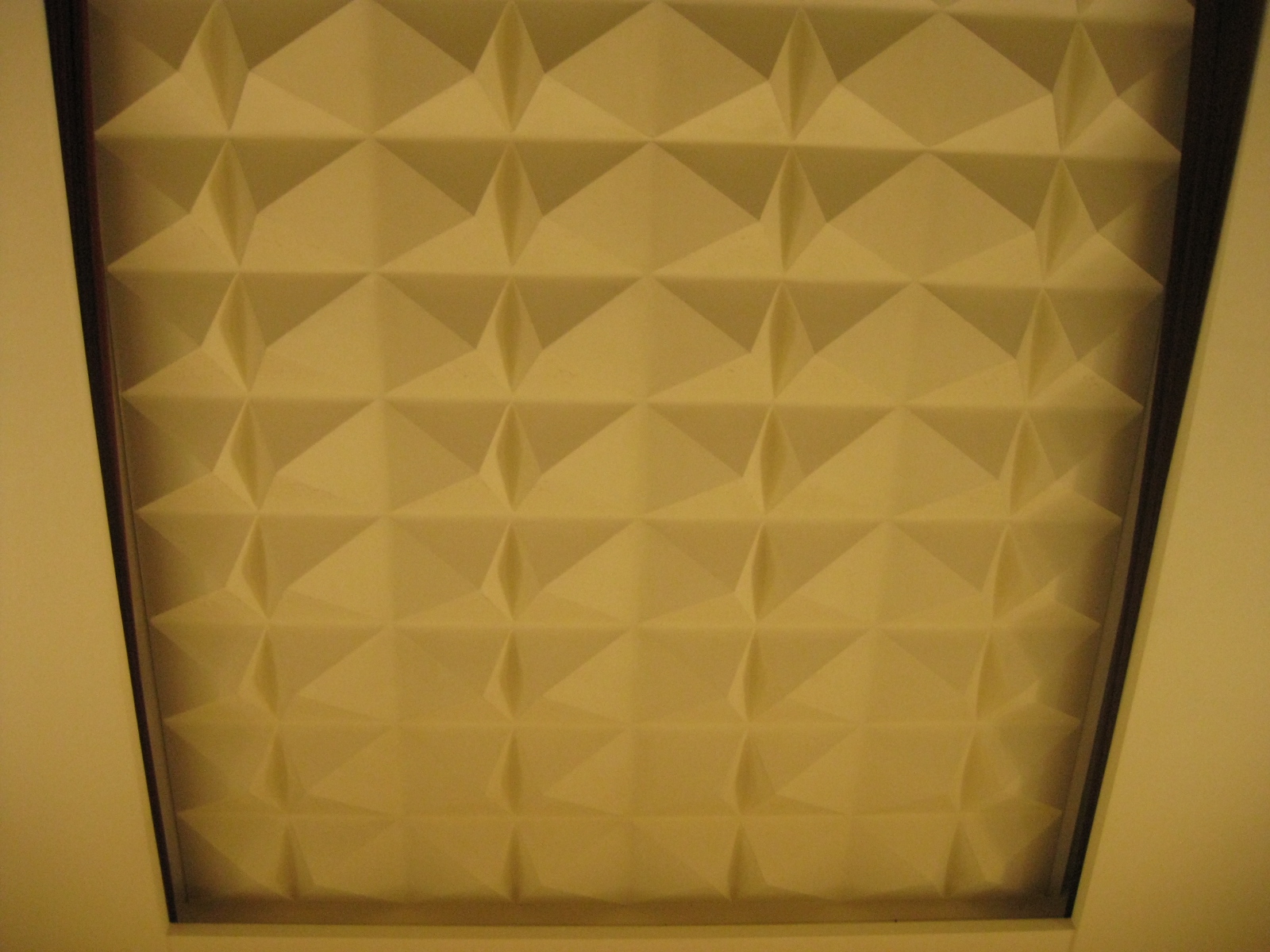PERFTECH
SYLLABUS
| You have two caps: PERF, and TECHs based on your known proficiencies, and your unknown proficiencies/ The TECHs will investigate deeper points about the technology presented, and the PERFs are to bring about humanisms from the patches PATCHES: |
MIKEDISKLAVIERThe goal is to take a MIKE of voice or monophonic instruments in to MSP, and through a process of distillation, rectification, calcination, putrefraction, et al., transmute it into MAX, which is the "mark", for transmission via MIDI to the DISKLAVIER.For the PERFs, A preliminary system is loaded, which uses spike~ to implement a rudimentary pitch follower. It is logarithmically compensated to make the piano match the voice. Working with the system live to explore its acousmatics. The TECHs will investigate how to use the "bags" of complex cartesians produced by FFT (fft~) and produce intelligent MIDI clouds out of the spectrum. Fourier was seeking a way to describe the transmission of heat- the Fourier Series. The question with sound is similar: "how does it go?". In quantum physics, everything is thus quantized to the Planck constant. Your goal is to mix the analytical nature of the FFT with the poetical implications of "granular synthesis" i.e. flocks, swarms, clouds. Nicolas Collins- talkingcuresoundslikenow Peter Ablinger- A Letter from Schoenberg "Ah, yes, I had a long email exchange with Ablinger about our respective pieces. I think he found mine obscenely irreverent."-Nicolas Collins How does an FFT work? By multiplying, then summing. On the top left, the product is all positive, so there is a net gain, i.e. that sine wave is detected. On the right, it is out of phase, so it is not detected by the reals, but it will be by the imaginaries. Thus we can think of a slightly detuned sine wave as spinning through reals and imaginaries as the phase changes. Can we use this spinning for a rhythmic purpose? |
| You have two caps: PERF, and TECHs based on your known proficiencies, and your unknown proficiencies/ The TECHs will investigate deeper points about the technology presented, and the PERFs are to bring about humanisms from the patches DISTILLUM O TH'SPACE |
FAIRCHILDMIKEGo to Fairchild Chapel. Please first read about the Brombaugh Organ there. It is enharmonic, so it speaks audible difference tones from the double articulated black keys. Time is spent using high-quality condenser microphones to mike the space, as well as spot miking the complex turbulence surrounding the lips of the organ pipes. There is also a Flentrop organ on the floor level of the chapel. Using 1/4" patch cords to (gently) wedge notes down. |
CHUBPATCHES: |
CHUBSZHere is an introduction to using hi in Max to manifest the sound of a Chub towards MSP. Print out the image, and analyze first on paper, then listen to the various permutations. Why is lores~ used on the gesture input?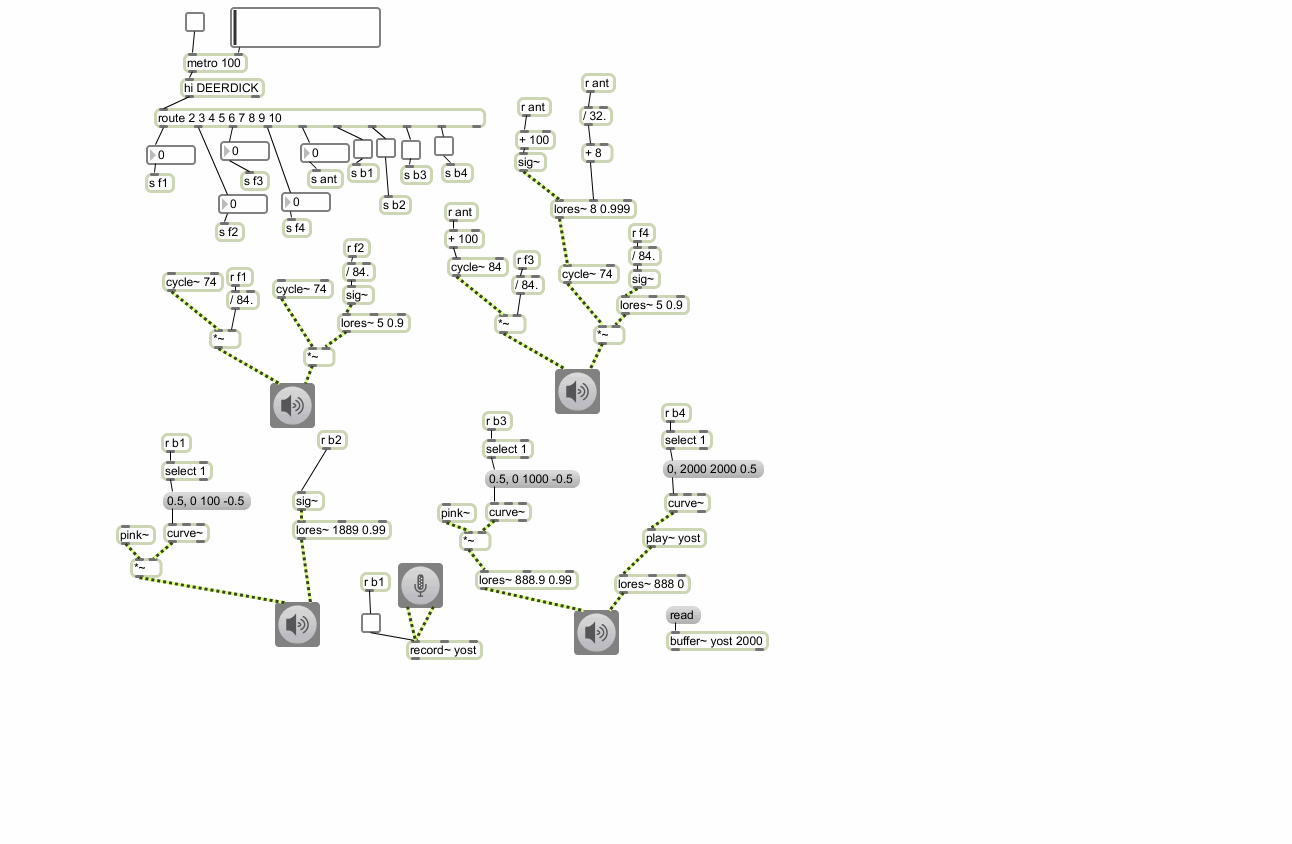 deerdik.maxpat Continuing with DSP for gestures, next we turn to modeling a state variable filter in MAX, not in MSP. This is because MSP's svf~ object only works down to about 5 Hertz, and we are interested in resonating slower waveforms even, such as Delta Waves. These waveforms are "performed" by the human brain during sleep, but they are also contained in gestures as taken as "wavelet" events, which are well resonated by the State Variable Filter model of a single resonance. 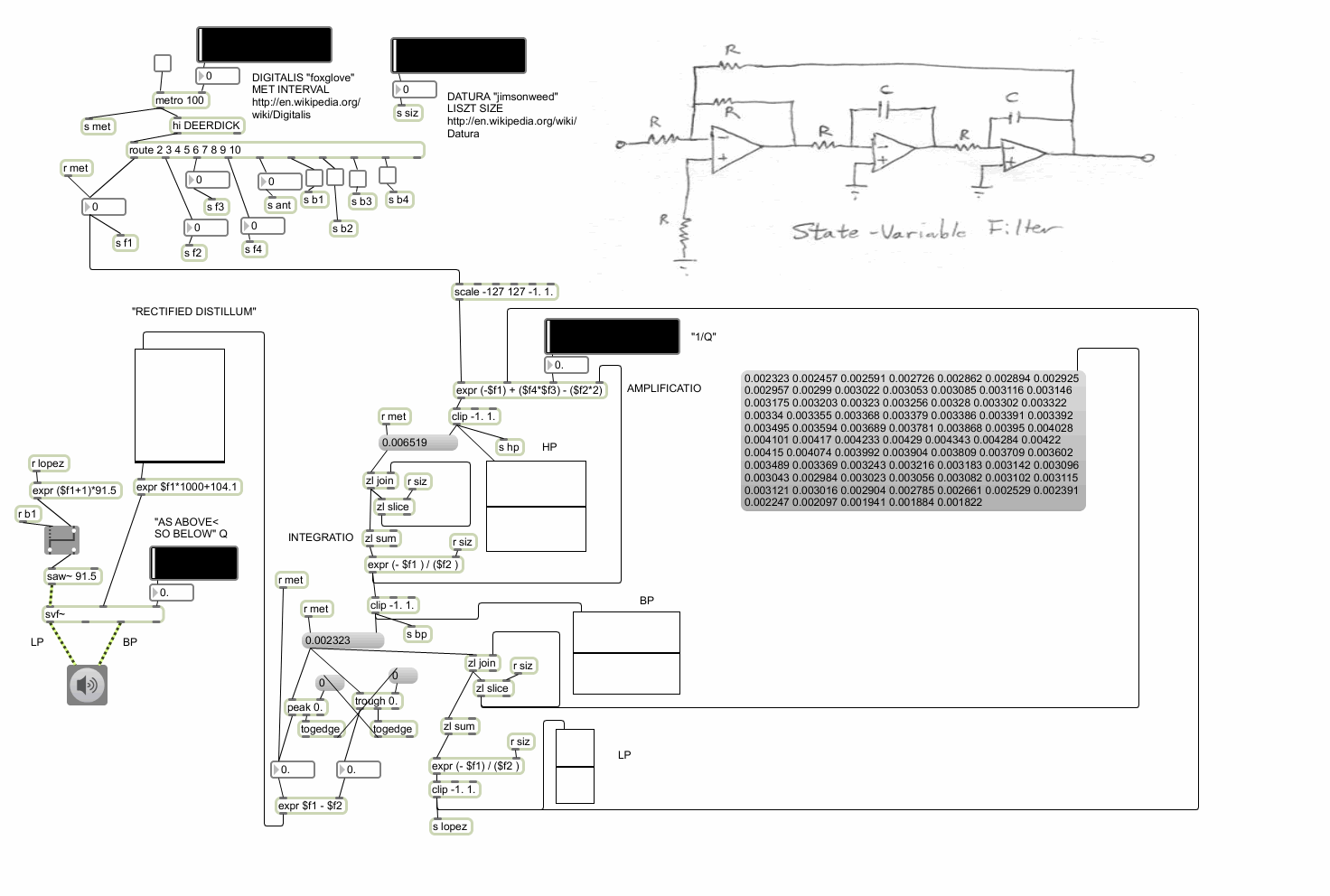 deerdoo.maxpat |
Peter B: Warner Song
thanks to the TECH 204 class, @Oberlin Conservatory, and also to Concert Productions in Bibbins, we were able to go in to Warner Concert Hall and experiment with tones there. A condenser mike was brought to the basement which captured the sound of a ticking relay, probably installed sometime in the 50s, for it is a very 50s fidelity hall. Peter B's "songus" is heard from the very back at the hall, where a wafered wall stands. It is composed of grassi imitations and frustrations.TUBASAMPLES: tubesza1 tubesza2 tubesza3 tubesza4 CHUBPATCHES: CHUBETUBES.zip (note CHUBETUBES also includes CHUBETUBESTOO, which uses a further patch, DEERTICULATE, to articulate the grains in octaves and other integral pitch leaps) |
TUBACHUBSZWe are going to create an ensemble using the chub devices and also a tubist. This is called "tubing the chubs". First let's look at some higher level implementations of the ideas discussed in "CHUBSZ". The following is a three part patch consisting of the following:
 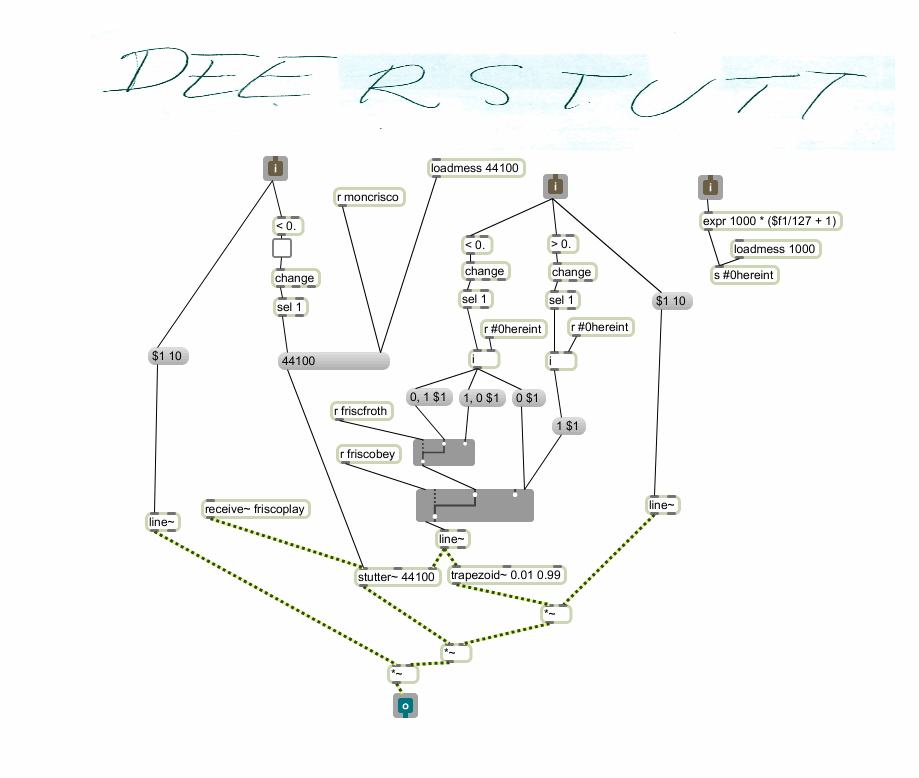 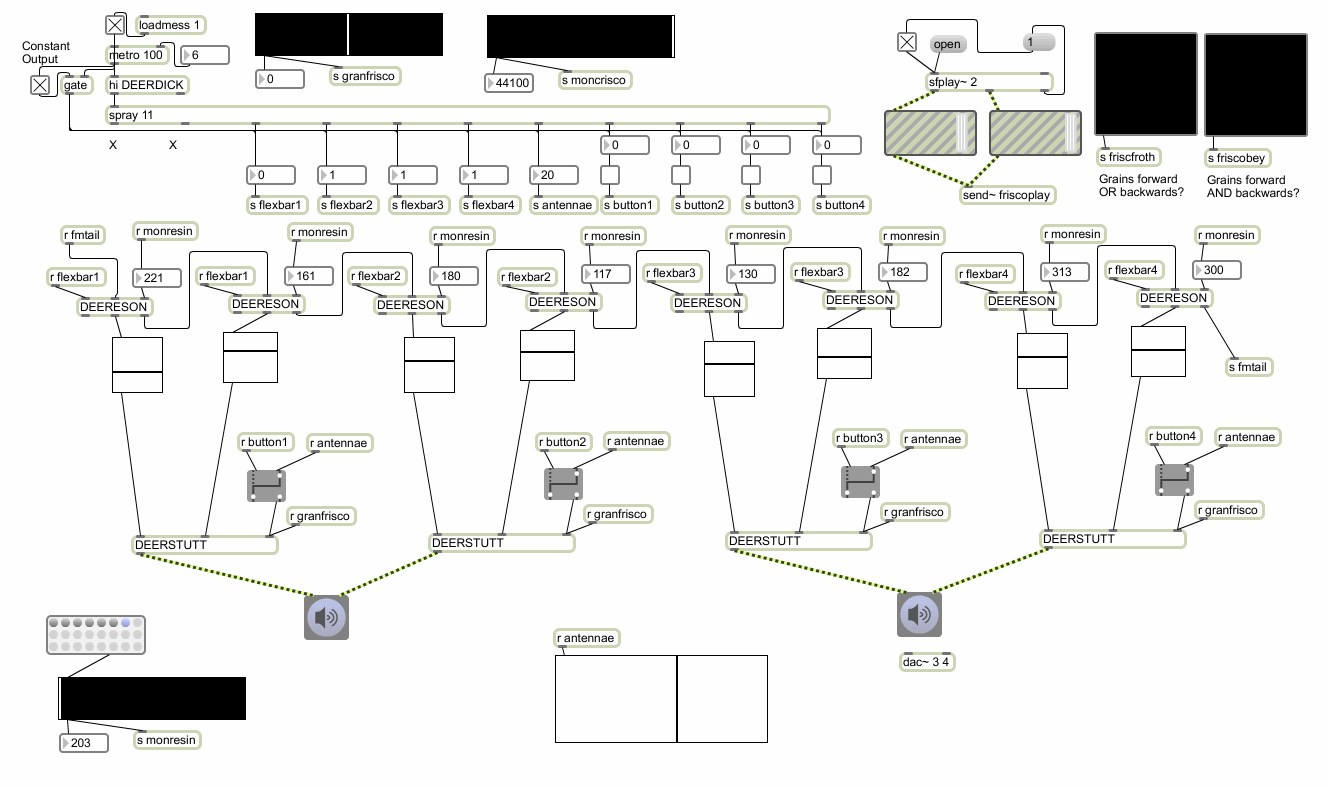 The main patch: CHUBETUBES Can we add further TUBES to the PERFTECH ensemble? |
JUSTINTSDownload JUSTINTS.zip
IMPORTANT: Windows exe in "winrelease" folder Macintosh app in "build/Release" folder instructions for a simplex patch using 3-limit Just Intonation:
|
the necessary materials: TUBAMIDIHORN.zip |
TUBAMIDIHORNNote the following patch is the craziest I ever built. There's nothing special or transcendental about it. It just uses simple effects.What is now going to be built in max/MSP is a highly arbitrary, pragmatic patch for making a "TUBAJAM" come out sounding really $%^&*ed up. The goals here are vague. I was researching the Noh aestheticist, Zeami, and came across this YouTube video of a Polish BluesMan, Igor Zenami. I decided to embed this youtube video in the patch, as inspiration for eventually working on a serious, academic patch for processing tuba. I then jammed with the youtube video, recorded that into protools, and also read a Greek narrator. These are the materials to be processed by the patch. Now, plugging a midihorn in to Max: 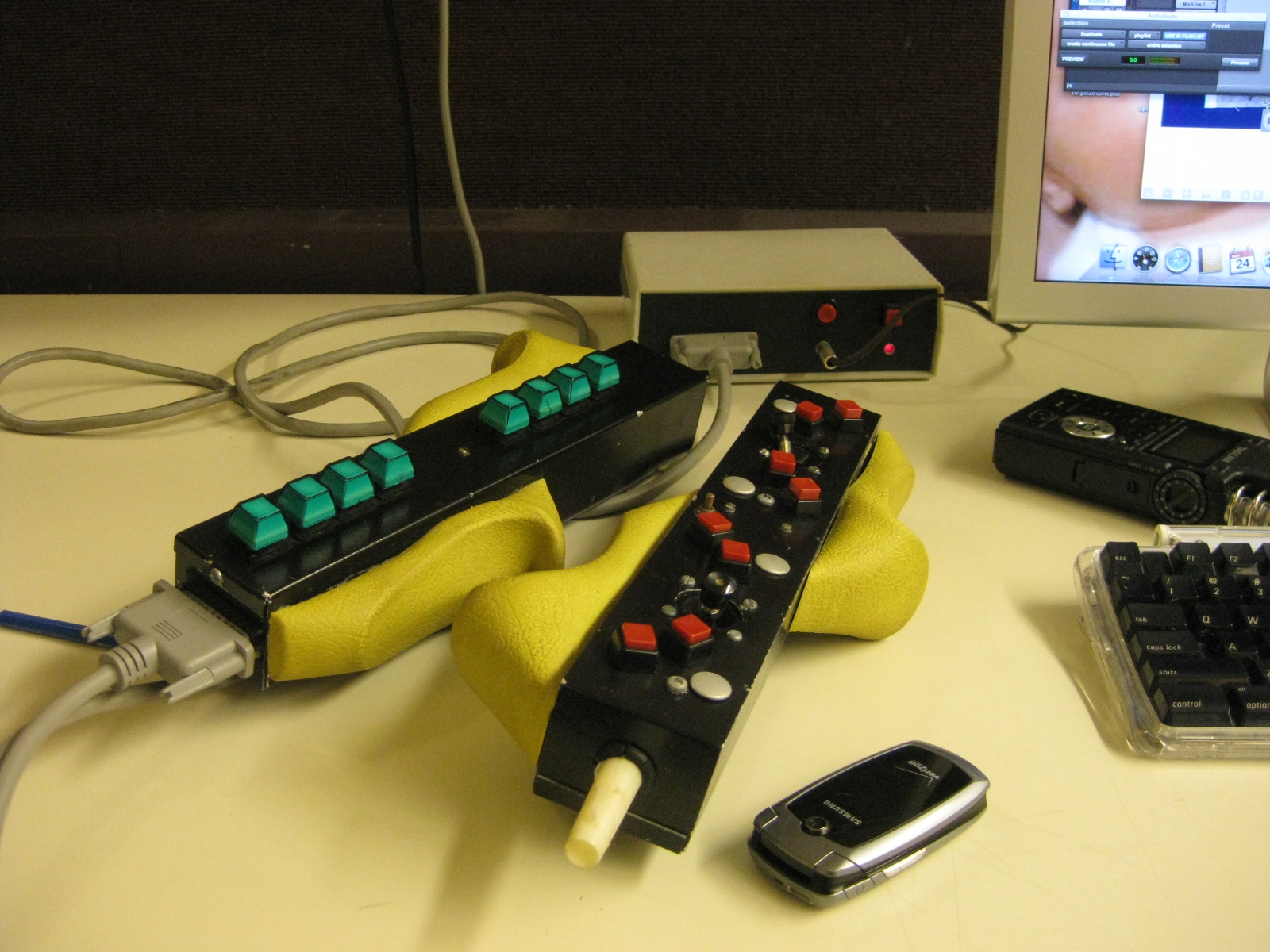 The midihorn has a printer cable on one end, and a breath tube on the other. What a device! It has two sets of valves that work like those on a tuba, nice (therapeutic?) foam hand grips, and on the back it has two joysticks and 8 buttons. The joysticks are great for controlling effects, such as a little bitcrusher made out of sah~, and also a lores~. The buttons on the back send out control signals which I use for my simple, general FM midi sounding "spacedrums". Now look how we process the tuba in this patch: 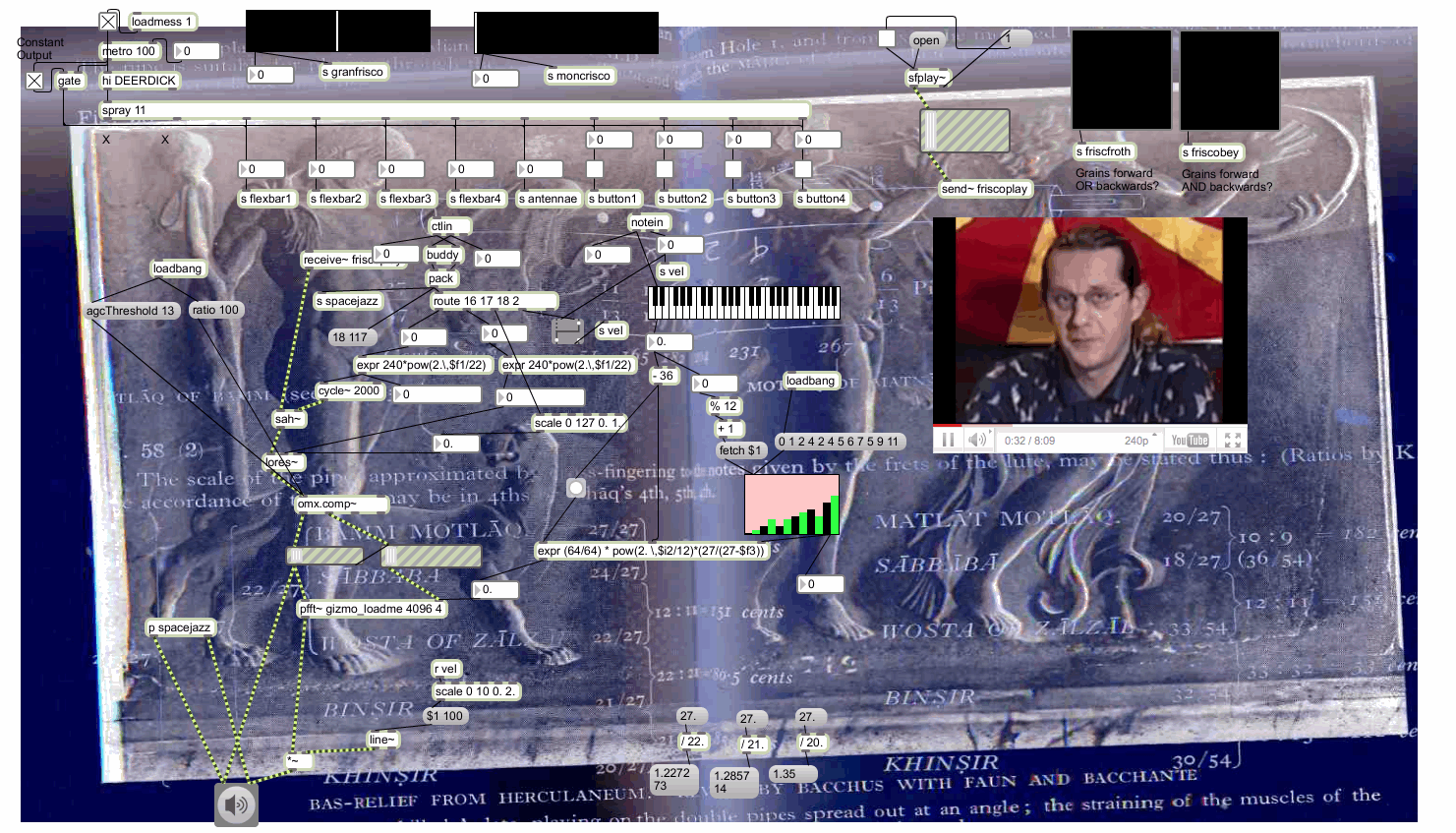 First of all, get the effects sauced on: sah~ makes bitcrusher as I said, plus lores~. Now for some compression, I used omx.comp~, and tweaked it so I can loadbang two messages in to it: AGCThreshold 13, and ratio 100, making it a pretty intense compressor. INTENSE COMPRESSION GOOD! Now, pop it into gizmo~, which is a pfft~ dingle/ it takes simple ratios in its right input to pitchshift. Ok, now since I'm in the habit of using alternative tunings, why not bring this tuba jam down into Ancient Greek theoretical land? Using the undertone scale, keeping the numerator constant at 27, and modulating the denominator, gives some nice Arabic intervals, including the Wosta of Zalzal, 27/22. For more on that theory of undertones, see this blog post- greek-aulos-kathleen-schlesinger. The background of this max patch is thus some plates of theory and bas-relief on ancient music. Now, please listen to the most ^$%*&ed up TUBAJAM max patch!: tubamidihorn/igorzeami.mp3 |
My 100 Frame Kinect Stop Animation
The Kinect, by Microsoft, is intended as video game controller, but it is also invaluable for performance situations. jit.freenect.grab not only gives you a 3-plane matrix stream from a normal webcam (in hi-def), it also gives you a 1-plane representation of the depth of objects in its view. Thus it is useful, using jit.3m to learn the population density of visitors to an installation, for example. This example is simple, it uses matrixset and a trigger to make a stop animation, inspired by VISITING LECTURER PAULINA VELAZQUEZ. Here is an archive of some simple patches using jit.freenect.grab. Besides the stop animator, there is also a simple theremin patch. All is in max/MSP/jitter, and it includes the necessary jit.freenect.grab external. kinectdemo.zipDocumentation of Broken Mackies Power Personal Amps
These amps are found to have melted due to extreme processing with loud sounds. Mackie seems to have used an "aesthetic of butter" when designing the power heat sinks, as you will often smell melting plastic when playing loud sounds. Eventually, the amplifiers stop amplifying and only parasitic oscillations are perceived; loud ultrasonic heat noises similar to natural radio emissions of the ionosphere. I rallied the class, with the help of Tyler Grice as main manipulator, to use these sounds musically, and here is the result, with the resulting spracht-stimme vocal imitations of the harsh electronic noises performed improvisationally by the vocals of the class.Adagio ma non Troppo, Rollable Installation in Studio 2, Peter B
Using Rollable Synthesizer, for a situation.ANALOGEMULATIONRungler |
SIDRAZZI GAMELANJohn Berndt, a Neoist from Baltimore,
approached me oh more than a year ago, asking about whether it would be
possible to create a sort of futurist gamelan out of Sidrazzi Organi. I said
yes, but it is already maximal as a solo instrument, so you might have
to ask your performers to use restraint. An important thing to
talk about as a performer in relationship to the technology. John
even came back to me with a few "definitions of constraints" which he
asked me to compose Neologisms for. Here is the pdf, which he
used to guide the Sidrazzi Gamelan that performed in Baltimore on April
16, 2011. SidrazziGamelanTerminology.pdf
We are to compose our own gamelan, using a proper ratio of sweet sidrazzis, and poppy tetrazzis, which I estimate to be about 5:1. There are six students in the class. With four sidrazzis we can use everychannel of an octophonic system, because they are stereo devices. With 6 organs total, there is a "cubic scheme" to use a quadrophonic system so that each instrument has a unique spatial relationship. This is listed as follows:
This piece is in memoriam Michel Waisvisz. I will thus try to channel his sincerity into a system of "organic hands", which are more like a conducting tool than a technology. |
A YouTube Video of Sidrazzi Gamelan, BALT
Sidrazzi Gamelan, as Performed by TECH 204, Spring 2011, Oberlin College TIMARA Department:
Sidrazzi Gamelan, as Performed by TECH 204, Spring 2011, Oberlin College TIMARA Department:
SIDRAZZIGAMELAN
